【深度学习】基于PyTorch搭建ResNet18、ResNet34、ResNet50、ResNet101、ResNet152网络_resnet34 resnet101-程序员宅基地
技术标签: resnet 深度学习 pytorch resnet18 34 resnet 101 152
一、使用PyTorch搭建ResNet18网络并使用CIFAR10数据集训练测试
1. ResNet18网络结构
所有不同层数的ResNet:
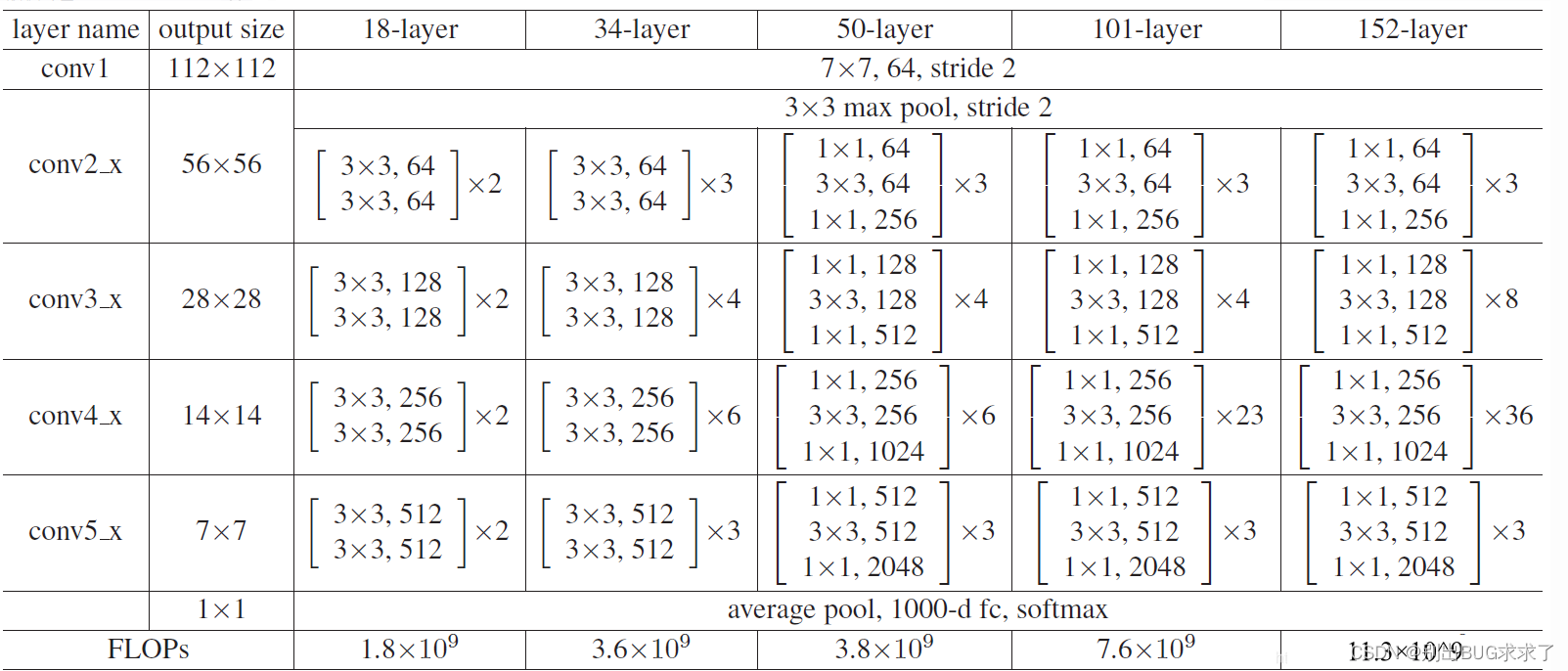
这里给出了我认为比较详细的ResNet18网络具体参数和执行流程图:
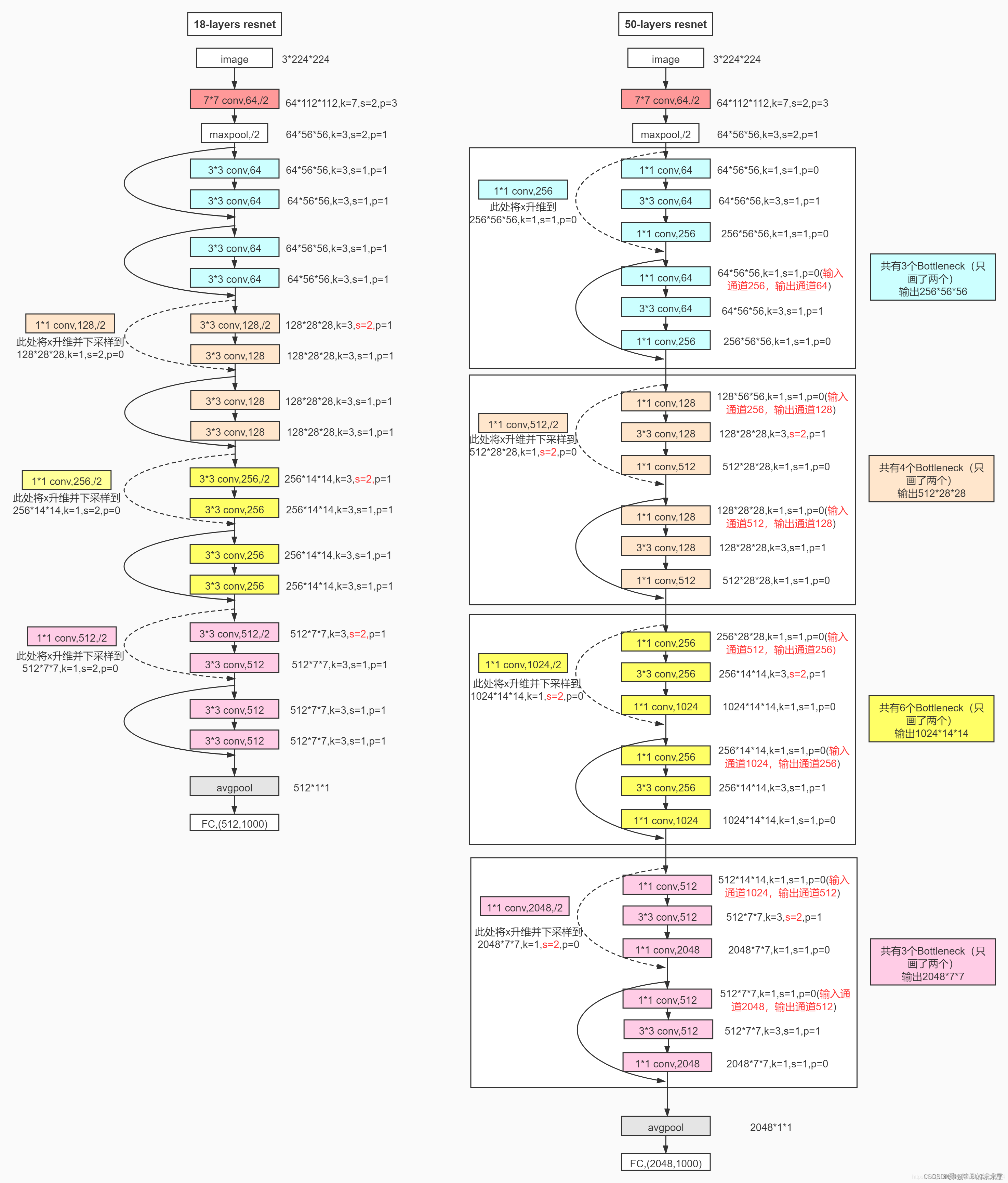
2. 实现代码
这里并未采用BasicBlock和BottleNeck复现ResNet18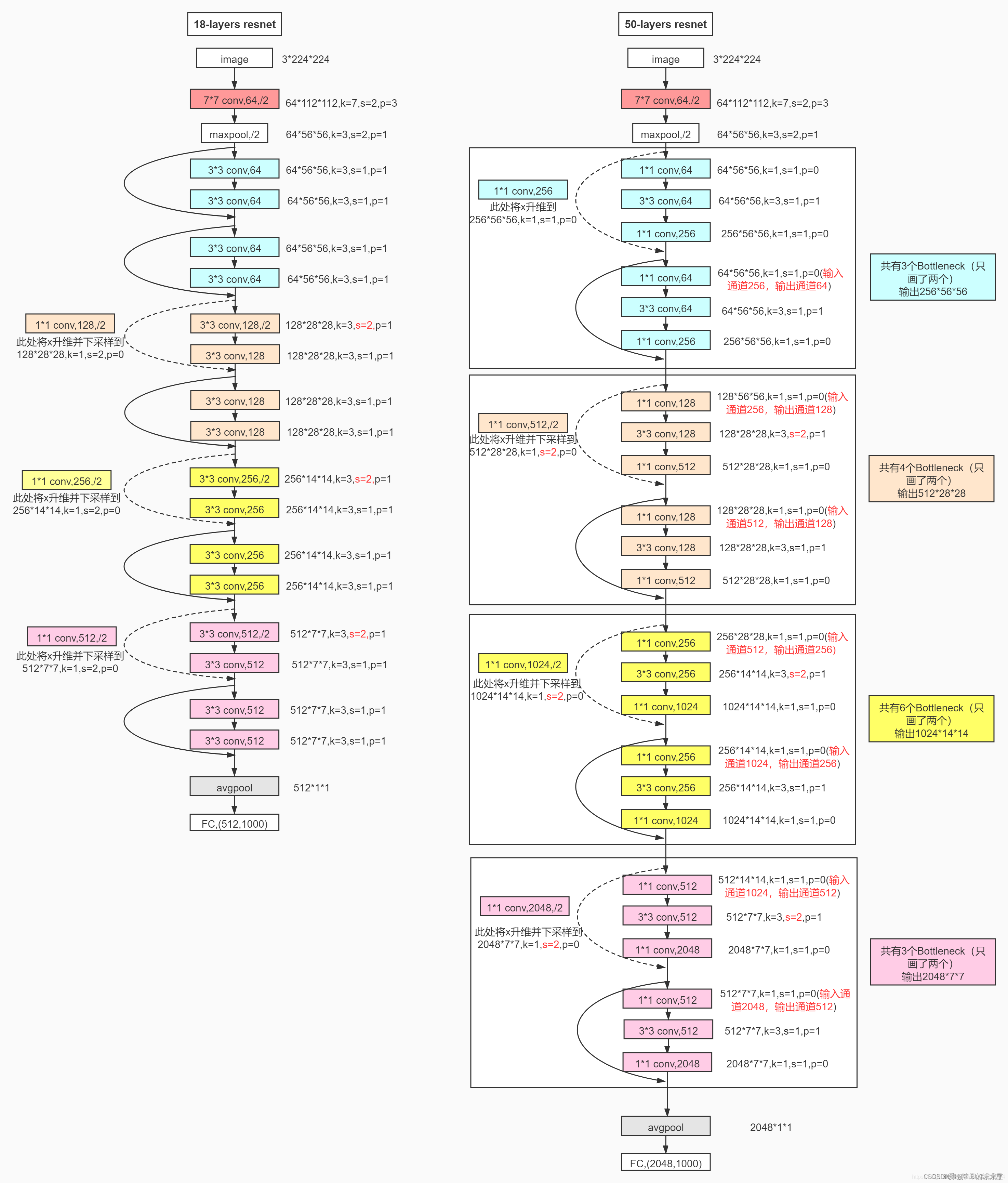
具体ResNet原理细节这里不多做描述,直接上代码
model.py网络模型部分:
import torch
import torch.nn as nn
from torch.nn import functional as F
"""
把ResNet18的残差卷积单元作为一个Block,这里分为两种:一种是CommonBlock,另一种是SpecialBlock,最后由ResNet18统筹调度
其中SpecialBlock负责完成ResNet18中带有虚线(升维channel增加和下采样操作h和w减少)的Block操作
其中CommonBlock负责完成ResNet18中带有实线的直接相连相加的Block操作
注意ResNet18中所有非shortcut部分的卷积kernel_size=3, padding=1,仅仅in_channel, out_channel, stride的不同
注意ResNet18中所有shortcut部分的卷积kernel_size=1, padding=0,仅仅in_channel, out_channel, stride的不同
"""
class CommonBlock(nn.Module):
def __init__(self, in_channel, out_channel, stride): # 普通Block简单完成两次卷积操作
super(CommonBlock, self).__init__()
self.conv1 = nn.Conv2d(in_channel, out_channel, kernel_size=3, stride=stride, padding=1, bias=False)
self.bn1 = nn.BatchNorm2d(out_channel)
self.conv2 = nn.Conv2d(out_channel, out_channel, kernel_size=3, stride=stride, padding=1, bias=False)
self.bn2 = nn.BatchNorm2d(out_channel)
def forward(self, x):
identity = x # 普通Block的shortcut为直连,不需要升维下采样
x = F.relu(self.bn1(self.conv1(x)), inplace=True) # 完成一次卷积
x = self.bn2(self.conv2(x)) # 第二次卷积不加relu激活函数
x += identity # 两路相加
return F.relu(x, inplace=True) # 添加激活函数输出
class SpecialBlock(nn.Module): # 特殊Block完成两次卷积操作,以及一次升维下采样
def __init__(self, in_channel, out_channel, stride): # 注意这里的stride传入一个数组,shortcut和残差部分stride不同
super(SpecialBlock, self).__init__()
self.change_channel = nn.Sequential( # 负责升维下采样的卷积网络change_channel
nn.Conv2d(in_channel, out_channel, kernel_size=1, stride=stride[0], padding=0, bias=False),
nn.BatchNorm2d(out_channel)
)
self.conv1 = nn.Conv2d(in_channel, out_channel, kernel_size=3, stride=stride[0], padding=1, bias=False)
self.bn1 = nn.BatchNorm2d(out_channel)
self.conv2 = nn.Conv2d(out_channel, out_channel, kernel_size=3, stride=stride[1], padding=1, bias=False)
self.bn2 = nn.BatchNorm2d(out_channel)
def forward(self, x):
identity = self.change_channel(x) # 调用change_channel对输入修改,为后面相加做变换准备
x = F.relu(self.bn1(self.conv1(x)), inplace=True)
x = self.bn2(self.conv2(x)) # 完成残差部分的卷积
x += identity
return F.relu(x, inplace=True) # 输出卷积单元
class ResNet18(nn.Module):
def __init__(self, classes_num):
super(ResNet18, self).__init__()
self.prepare = nn.Sequential( # 所有的ResNet共有的预处理==》[batch, 64, 56, 56]
nn.Conv2d(3, 64, 7, 2, 3),
nn.BatchNorm2d(64),
nn.ReLU(inplace=True),
nn.MaxPool2d(3, 2, 1)
)
self.layer1 = nn.Sequential( # layer1有点特别,由于输入输出的channel均是64,故两个CommonBlock
CommonBlock(64, 64, 1),
CommonBlock(64, 64, 1)
)
self.layer2 = nn.Sequential( # layer234类似,由于输入输出的channel不同,故一个SpecialBlock,一个CommonBlock
SpecialBlock(64, 128, [2, 1]),
CommonBlock(128, 128, 1)
)
self.layer3 = nn.Sequential(
SpecialBlock(128, 256, [2, 1]),
CommonBlock(256, 256, 1)
)
self.layer4 = nn.Sequential(
SpecialBlock(256, 512, [2, 1]),
CommonBlock(512, 512, 1)
)
self.pool = nn.AdaptiveAvgPool2d(output_size=(1, 1)) # 卷积结束,通过一个自适应均值池化==》 [batch, 512, 1, 1]
self.fc = nn.Sequential( # 最后用于分类的全连接层,根据需要灵活变化
nn.Dropout(p=0.5),
nn.Linear(512, 256),
nn.ReLU(inplace=True),
nn.Dropout(p=0.5),
nn.Linear(256, classes_num) # 这个使用CIFAR10数据集,定为10分类
)
def forward(self, x):
x = self.prepare(x) # 预处理
x = self.layer1(x) # 四个卷积单元
x = self.layer2(x)
x = self.layer3(x)
x = self.layer4(x)
x = self.pool(x) # 池化
x = x.reshape(x.shape[0], -1) # 将x展平,输入全连接层
x = self.fc(x)
return x
train.py训练部分(使用CIFAR10数据集):
import torch
import visdom
from torch.utils.data import DataLoader
from torchvision import datasets, transforms
from PIL import Image
from matplotlib import pyplot as plt
import numpy as np
from ResNet18 import ResNet18
from torch.nn import CrossEntropyLoss
from torch import optim
BATCH_SIZE = 512 # 超参数batch大小
EPOCH = 30 # 总共训练轮数
save_path = "./CIFAR10_ResNet18.pth" # 模型权重参数保存位置
# classes = ('plane', 'car', 'bird', 'cat', 'deer', 'dog', 'frog', 'horse', 'ship', 'truck') # CIFAR10数据集类别
device = torch.device("cuda:0" if torch.cuda.is_available() else "cpu") # 创建GPU运算环境
print(device)
data_transform = {
# 数据预处理
"train": transforms.Compose([
transforms.ToTensor(),
transforms.Normalize((0.5, 0.5, 0.5), (0.5, 0.5, 0.5))
]),
"val": transforms.Compose([
transforms.ToTensor(),
transforms.Normalize((0.5, 0.5, 0.5), (0.5, 0.5, 0.5))
])
}
# 加载数据集,指定训练或测试数据,指定于处理方式
train_data = datasets.CIFAR10(root='./CIFAR10/', train=True, transform=data_transform["train"], download=True)
test_data = datasets.CIFAR10(root='./CIFAR10/', train=False, transform=data_transform["val"], download=True)
train_dataloader = torch.utils.data.DataLoader(train_data, BATCH_SIZE, True, num_workers=0)
test_dataloader = torch.utils.data.DataLoader(test_data, BATCH_SIZE, False, num_workers=0)
# # 展示图片
# x = 0
# for images, labels in train_data:
# plt.subplot(3,3,x+1)
# plt.tight_layout()
# images = images.numpy().transpose(1, 2, 0) # 把channel那一维放到最后
# plt.title(str(classes[labels]))
# plt.imshow(images)
# plt.xticks([])
# plt.yticks([])
# x += 1
# if x == 9:
# break
# plt.show()
# 创建一个visdom,将训练测试情况可视化
viz = visdom.Visdom()
# 测试函数,传入模型和数据读取接口
def evalute(model, loader):
# correct为总正确数量,total为总测试数量
correct = 0
total = len(loader.dataset)
# 取测试数据
for x, y in loader:
x, y = x.to(device), y.to(device)
# validation和test过程不需要反向传播
model.eval()
with torch.no_grad():
out = model(x) # 计算测试数据的输出logits
# 计算出out在第一维度上最大值对应编号,得模型的预测值
prediction = out.argmax(dim=1)
# 预测正确的数量correct
correct += torch.eq(prediction, y).float().sum().item()
# 最终返回正确率
return correct / total
net = ResNet18()
net.to(device) # 实例化网络模型并送入GPU
net.load_state_dict(torch.load(save_path)) # 使用上次训练权重接着训练
optimizer = optim.Adam(net.parameters(), lr=0.001) # 定义优化器
loss_function = CrossEntropyLoss() # 多分类问题使用交叉熵损失函数
best_acc, best_epoch = 0.0, 0 # 最好准确度,出现的轮数
global_step = 0 # 全局的step步数,用于画图
for epoch in range(EPOCH):
running_loss = 0.0 # 一次epoch的总损失
net.train() # 开始训练
for step, (images, labels) in enumerate(train_dataloader, start=0):
images, labels = images.to(device), labels.to(device)
optimizer.zero_grad()
outputs = net(images)
loss = loss_function(outputs, labels)
loss.backward()
optimizer.step()
running_loss += loss.item() # 将一个epoch的损失累加
# 打印输出当前训练的进度
rate = (step + 1) / len(train_dataloader)
a = "*" * int(rate * 50)
b = "." * int((1 - rate) * 50)
print("\repoch: {} train loss: {:^3.0f}%[{}->{}]{:.3f}".format(epoch+1, int(rate * 100), a, b, loss), end="")
# 记录test的loss
viz.line([loss.item()], [global_step], win='loss', update='append')
# 每次记录之后将横轴x的值加一
global_step += 1
# 在每一个epoch结束,做一次test
if epoch % 1 == 0:
# 使用上面定义的evalute函数,测试正确率,传入测试模型net,测试数据集test_dataloader
test_acc = evalute(net, test_dataloader)
print(" epoch{} test acc:{}".format(epoch+1, test_acc))
# 根据目前epoch计算所得的acc,看看是否需要保存当前状态(即当前的各项参数值)以及迭代周期epoch作为最好情况
if test_acc > best_acc:
# 保存最好数据
best_acc = test_acc
best_epoch = epoch
# 保存最好的模型参数值状态
torch.save(net.state_dict(), save_path)
# 记录validation的val_acc
viz.line([test_acc], [global_step], win='test_acc', update='append')
print("Finish !")
3. 训练测试结果
训练损失:

每一个epoch结束之后的测试:
训练时多次修改超参数,最后经过30次epoch之后的测试准确度达到了0.7471,没有在训练下去也没有明显提升,初学深度神经网络,第一次搭建ResNet,我的数据处理等方面处理的有一定欠缺,大家有好的建议也可以提出来
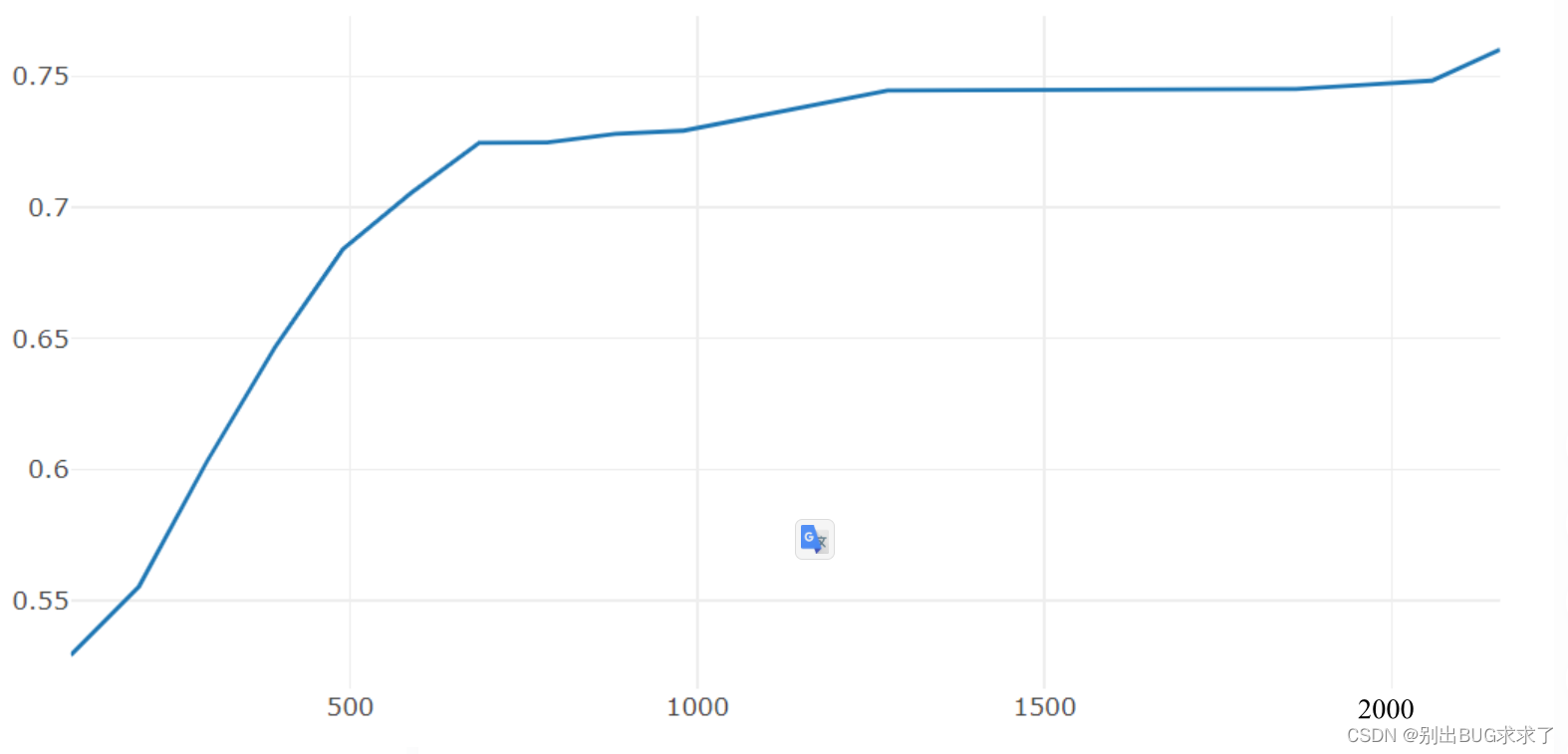
二、使用PyTorch搭建ResNet34网络
1. ResNet34网络结构
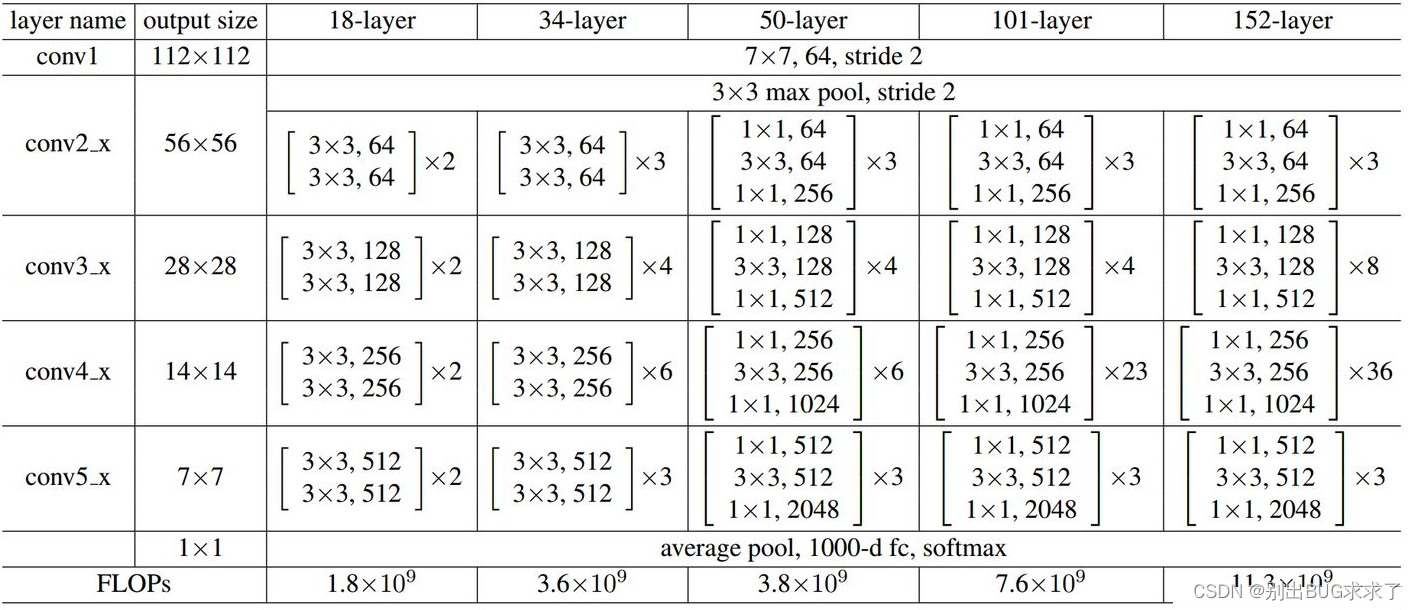
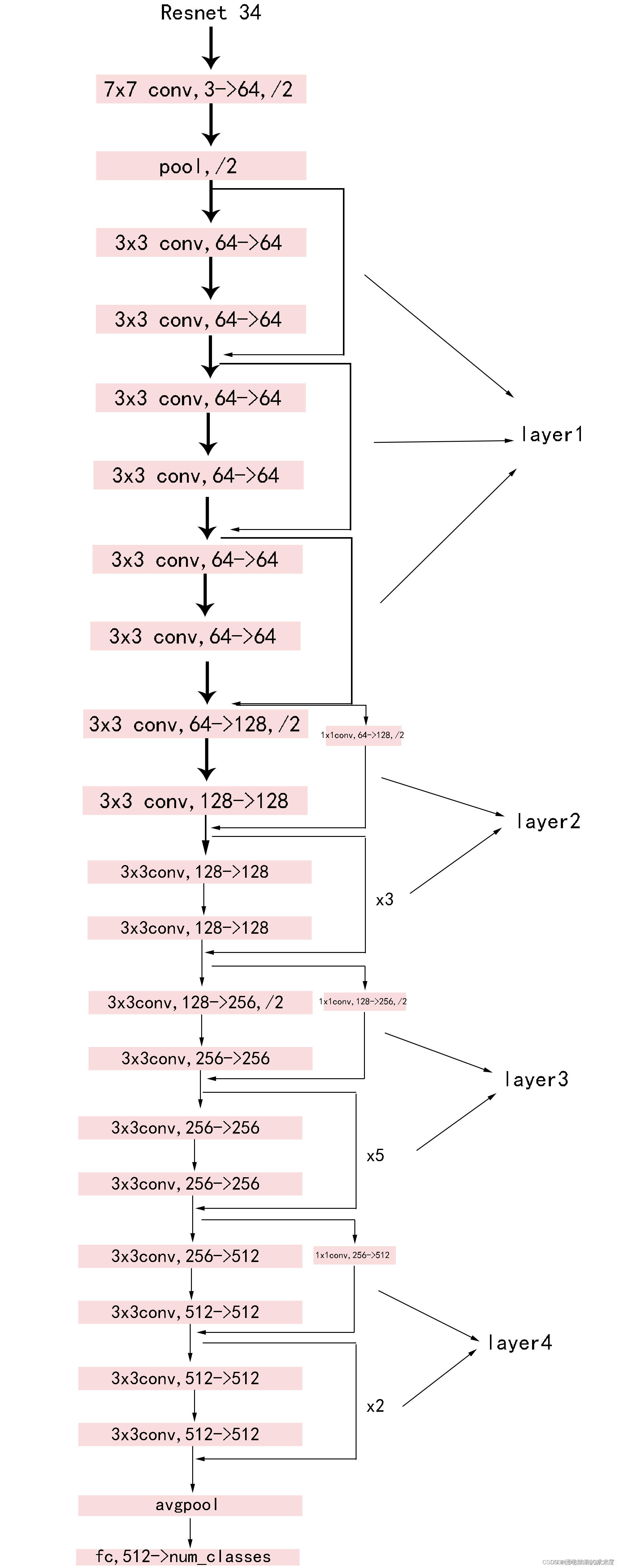
参照ResNet18的搭建,由于34层和18层几乎相同,叠加卷积单元数即可,所以没有写注释,具体可以参考我的ResNet18搭建中的注释,ResNet34的训练部分也可以参照。
2. 实现代码
import torch
import torch.nn as nn
from torch.nn import functional as F
class CommonBlock(nn.Module):
def __init__(self, in_channel, out_channel, stride):
super(CommonBlock, self).__init__()
self.conv1 = nn.Conv2d(in_channel, out_channel, kernel_size=3, stride=stride, padding=1, bias=False)
self.bn1 = nn.BatchNorm2d(out_channel)
self.conv2 = nn.Conv2d(out_channel, out_channel, kernel_size=3, stride=stride, padding=1, bias=False)
self.bn2 = nn.BatchNorm2d(out_channel)
def forward(self, x):
identity = x
x = F.relu(self.bn1(self.conv1(x)), inplace=True)
x = self.bn2(self.conv2(x))
x += identity
return F.relu(x, inplace=True)
class SpecialBlock(nn.Module):
def __init__(self, in_channel, out_channel, stride):
super(SpecialBlock, self).__init__()
self.change_channel = nn.Sequential(
nn.Conv2d(in_channel, out_channel, kernel_size=1, stride=stride[0], padding=0, bias=False),
nn.BatchNorm2d(out_channel)
)
self.conv1 = nn.Conv2d(in_channel, out_channel, kernel_size=3, stride=stride[0], padding=1, bias=False)
self.bn1 = nn.BatchNorm2d(out_channel)
self.conv2 = nn.Conv2d(out_channel, out_channel, kernel_size=3, stride=stride[1], padding=1, bias=False)
self.bn2 = nn.BatchNorm2d(out_channel)
def forward(self, x):
identity = self.change_channel(x)
x = F.relu(self.bn1(self.conv1(x)), inplace=True)
x = self.bn2(self.conv2(x))
x += identity
return F.relu(x, inplace=True)
class ResNet34(nn.Module):
def __init__(self, classes_num):
super(ResNet34, self).__init__()
self.prepare = nn.Sequential(
nn.Conv2d(3, 64, 7, 2, 3),
nn.BatchNorm2d(64),
nn.ReLU(inplace=True),
nn.MaxPool2d(3, 2, 1)
)
self.layer1 = nn.Sequential(
CommonBlock(64, 64, 1),
CommonBlock(64, 64, 1),
CommonBlock(64, 64, 1)
)
self.layer2 = nn.Sequential(
SpecialBlock(64, 128, [2, 1]),
CommonBlock(128, 128, 1),
CommonBlock(128, 128, 1),
CommonBlock(128, 128, 1)
)
self.layer3 = nn.Sequential(
SpecialBlock(128, 256, [2, 1]),
CommonBlock(256, 256, 1),
CommonBlock(256, 256, 1),
CommonBlock(256, 256, 1),
CommonBlock(256, 256, 1),
CommonBlock(256, 256, 1)
)
self.layer4 = nn.Sequential(
SpecialBlock(256, 512, [2, 1]),
CommonBlock(512, 512, 1),
CommonBlock(512, 512, 1)
)
self.pool = nn.AdaptiveAvgPool2d(output_size=(1, 1))
self.fc = nn.Sequential(
nn.Dropout(p=0.5),
nn.Linear(512, 256),
nn.ReLU(inplace=True),
nn.Dropout(p=0.5),
nn.Linear(256, classes_num)
)
def forward(self, x):
x = self.prepare(x)
x = self.layer1(x)
x = self.layer2(x)
x = self.layer3(x)
x = self.layer4(x)
x = self.pool(x)
x = x.reshape(x.shape[0], -1)
x = self.fc(x)
return x
三、使用PyTorch搭建ResNet50网络
看过我之前ResNet18和ResNet34搭建的朋友可能想着可不可以把搭建18和34层的方法直接用在50层以上的ResNet的搭建中,我也尝试过。但是ResNet50以上的网络搭建不像是18到34层只要简单修改卷积单元数目就可以完成,ResNet50以上的三种网络都是一个样子,只是层数不同,所以完全可以将34到50层作为一个搭建分水岭。
加上我初学PyTorch和深度神经网络,对于采用BasicBlock和BottleNeck的高效率构建还不是很懂,所以这里给出了类似前两种ResNet的简单暴力堆叠网络层的构建方法
1. ResNet50网络结构
所有不同层数的ResNet:
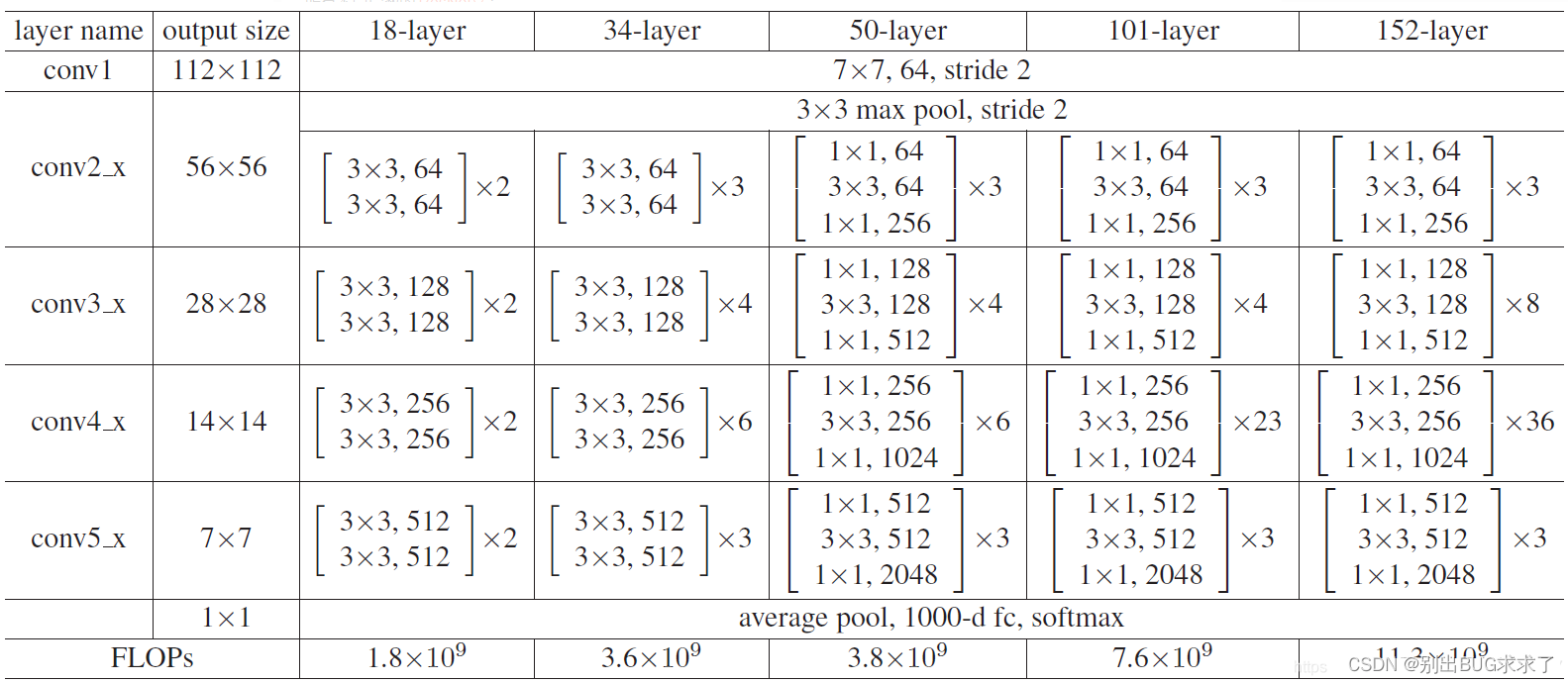
这里给出了我认为比较详细的ResNet50网络具体参数和执行流程图:

2. 实现代码
model.py模型部分:
import torch
import torch.nn as nn
from torch.nn import functional as F
"""
这里的ResNet50的搭建是暴力形式,直接累加完成搭建,没采用BasicBlock和BottleNeck
第一个DownSample类,用于定义shortcut的模型函数,完成两个layer之间虚线的shortcut,负责layer1虚线的升4倍channel以及其他layer虚线的升2倍channel
观察每一个layer的虚线处升channel仅仅是升channel前后的数量不同以及stride不同,对于kernel_size和padding都分别是1和0,不作为DownSample网络类的模型参数
参数in_channel即是升之前的通道数, out_channel即是升之后的通道数, stride即是每一次升channel不同的stride步长,对于layer1升通道的stride=1,其他layer升通道的stride=2,注意不同
"""
"""
运行时一定要注意:
本网络中的ResNet50类中forward函数里面:layer1_shortcut1.to('cuda:0');layer2_shortcut1.to('cuda:0')等语句,是将实例化的DownSample
网络模型放到train.py训练脚本中定义的GPU同一环境下,不加此句一般会如下报错:
Input type (torch.cuda.FloatTensor) and weight type (torch.FloatTensor) should be the same
"""
class DownSample(nn.Module):
def __init__(self, in_channel, out_channel, stride): # 传入下采样的前后channel数以及stride步长
super(DownSample, self).__init__() # 继承父类
self.down = nn.Sequential( # 定义一个模型容器down
nn.Conv2d(in_channel, out_channel, kernel_size=1, stride=stride, padding=0, bias=False), # 负责虚线shortcut的唯一且重要的一次卷积
nn.BatchNorm2d(out_channel), # 在卷积和ReLU非线性激活之间,添加BatchNormalization
nn.ReLU(inplace=True) # shortcut最后加入一个激活函数,置inplace=True原地操作,节省内存
)
def forward(self, x):
out = self.down(x) # 前向传播函数仅仅完成down这个容器的操作
return out
"""
第一个ResNet50类,不使用BottleNeck单元完成ResNet50层以上的搭建,直接使用forward再加上前面的DownSample模型类函数,指定ResNet50所有参数构建模型
"""
class ResNet50(nn.Module):
def __init__(self, classes_num): # ResNet50仅传一个分类数目,将涉及的所有数据写死,具体数据可以参考下面的图片
super(ResNet50, self).__init__()
# 在进入layer1234之间先进行预处理,主要是一次卷积一次池化,从[batch, 3, 224, 224] => [batch, 64, 56, 56]
self.pre = nn.Sequential(
# 卷积channel从原始数据的3通道,采用64个卷积核,升到64个channel,卷积核大小、步长、padding均固定
nn.Conv2d(3, 64, kernel_size=7, stride=2, padding=3, bias=False),
nn.BatchNorm2d(64), # 卷积后紧接一次BatchNormalization
nn.ReLU(inplace=True),
nn.MaxPool2d(kernel_size=3, stride=2, padding=1) # 预处理最后的一次最大池化操作,数据固定
)
"""
每一个layer的操作分为使用一次的first,和使用多次的next组成,first负责每个layer的第一个单元(有虚线)的三次卷积,next负责剩下单元(直连)的三次卷积
"""
# --------------------------------------------------------------
self.layer1_first = nn.Sequential(
nn.Conv2d(64, 64, kernel_size=1, stride=1, padding=0, bias=False), # layer1_first第一次卷积保持channel不变,和其他layer的first区别
nn.BatchNorm2d(64),
nn.ReLU(inplace=True),
nn.Conv2d(64, 64, kernel_size=3, stride=1, padding=1, bias=False), # layer1_first第二次卷积stride和其他layer_first的stride不同
nn.BatchNorm2d(64),
nn.ReLU(inplace=True),
nn.Conv2d(64, 256, kernel_size=1, stride=1, padding=0, bias=False), # layer1_first第三次卷积和其他layer一样,channel升4倍
nn.BatchNorm2d(256) # 注意最后一次卷积结束不加ReLU激活函数
)
self.layer1_next = nn.Sequential(
nn.Conv2d(256, 64, kernel_size=1, stride=1, padding=0, bias=False), # layer1_next的第一次卷积负责将channel减少,减少训练参数量
nn.BatchNorm2d(64),
nn.ReLU(inplace=True),
nn.Conv2d(64, 64, kernel_size=3, stride=1, padding=1, bias=False),
nn.BatchNorm2d(64),
nn.ReLU(inplace=True),
nn.Conv2d(64, 256, kernel_size=1, stride=1, padding=0, bias=False), # layer1_next的最后一次卷积负责将channel增加至可以与shortcut相加
nn.BatchNorm2d(256)
)
# -------------------------------------------------------------- # layer234操作基本相同,这里仅介绍layer2
self.layer2_first = nn.Sequential(
nn.Conv2d(256, 128, kernel_size=1, stride=1, padding=0, bias=False), # 与layer1_first第一次卷积不同,需要降channel至1/2
nn.BatchNorm2d(128),
nn.ReLU(inplace=True),
nn.Conv2d(128, 128, kernel_size=3, stride=2, padding=1, bias=False), # 注意这里的stride=2与layer34相同,与layer1区别
nn.BatchNorm2d(128),
nn.ReLU(inplace=True),
nn.Conv2d(128, 512, kernel_size=1, stride=1, padding=0, bias=False), # 再次升channel
nn.BatchNorm2d(512)
)
self.layer2_next = nn.Sequential(
nn.Conv2d(512, 128, kernel_size=1, stride=1, padding=0, bias=False), # 负责循环普通的操作
nn.BatchNorm2d(128),
nn.ReLU(inplace=True),
nn.Conv2d(128, 128, kernel_size=3, stride=1, padding=1, bias=False),
nn.BatchNorm2d(128),
nn.ReLU(inplace=True),
nn.Conv2d(128, 512, kernel_size=1, stride=1, padding=0, bias=False),
nn.BatchNorm2d(512)
)
# --------------------------------------------------------------
self.layer3_first = nn.Sequential(
nn.Conv2d(512, 256, kernel_size=1, stride=1, padding=0, bias=False),
nn.BatchNorm2d(256),
nn.ReLU(inplace=True),
nn.Conv2d(256, 256, kernel_size=3, stride=2, padding=1, bias=False),
nn.BatchNorm2d(256),
nn.ReLU(inplace=True),
nn.Conv2d(256, 1024, kernel_size=1, stride=1, padding=0, bias=False),
nn.BatchNorm2d(1024)
)
self.layer3_next = nn.Sequential(
nn.Conv2d(1024, 256, kernel_size=1, stride=1, padding=0, bias=False),
nn.BatchNorm2d(256),
nn.ReLU(inplace=True),
nn.Conv2d(256, 256, kernel_size=3, stride=1, padding=1, bias=False),
nn.BatchNorm2d(256),
nn.ReLU(inplace=True),
nn.Conv2d(256, 1024, kernel_size=1, stride=1, padding=0, bias=False),
nn.BatchNorm2d(1024)
)
# --------------------------------------------------------------
self.layer4_first = nn.Sequential(
nn.Conv2d(1024, 512, kernel_size=1, stride=1, padding=0, bias=False),
nn.BatchNorm2d(512),
nn.ReLU(inplace=True),
nn.Conv2d(512, 512, kernel_size=3, stride=2, padding=1, bias=False),
nn.BatchNorm2d(512),
nn.ReLU(inplace=True),
nn.Conv2d(512, 2048, kernel_size=1, stride=1, padding=0, bias=False),
nn.BatchNorm2d(2048)
)
self.layer4_next = nn.Sequential(
nn.Conv2d(2048, 512, kernel_size=1, stride=1, padding=0, bias=False),
nn.BatchNorm2d(512),
nn.ReLU(inplace=True),
nn.Conv2d(512, 512, kernel_size=3, stride=1, padding=1, bias=False),
nn.BatchNorm2d(512),
nn.ReLU(inplace=True),
nn.Conv2d(512, 2048, kernel_size=1, stride=1, padding=0, bias=False),
nn.BatchNorm2d(2048)
)
self.avg_pool = nn.AdaptiveAvgPool2d((1, 1)) # 经过最后的自适应均值池化为[batch, 2048, 1, 1]
# 定义最后的全连接层
self.fc = nn.Sequential(
nn.Dropout(p=0.5), # 以0.5的概率失活神经元
nn.Linear(2048 * 1 * 1, 1024), # 第一个全连接层
nn.ReLU(inplace=True),
nn.Dropout(p=0.5),
nn.Linear(1024, classes_num) # 第二个全连接层,输出类结果
)
"""
forward()前向传播函数负责将ResNet类中定义的网络层复用,再与上面的DownSample类完美组合
"""
def forward(self, x):
out = self.pre(x) # 对输入预处理,输出out = [batch, 64, 56, 56]
"""
每一层layer操作由两个部分组成,第一个是带有虚线的卷积单元,其他的是循环完成普通的shortcut为直连的卷积单元
"""
layer1_shortcut1 = DownSample(64, 256, 1) # 使用DownSample实例化一个网络模型layer1_shortcut1,参数即是虚线处升channel数据,注意stride=1
layer1_shortcut1.to('cuda:0')
layer1_identity1 = layer1_shortcut1(out) # 调用layer1_shortcut1对卷积单元输入out计算虚线处的identity,用于后面与卷积单元输出相加
out = self.layer1_first(out) # 调用layer1_first完成layer1的第一个特殊的卷积单元
out = F.relu(out + layer1_identity1, inplace=True) # 将identity与卷积单元输出相加,经过relu激活函数
for i in range(2): # 使用循环完成后面几个相同输入输出相同操作的卷积单元
layer_identity = out # 直接直连identity等于输入
out = self.layer1_next(out) # 输入经过普通卷积单元
out = F.relu(out + layer_identity, inplace=True) # 两路结果相加,再经过激活函数
# --------------------------------------------------------------后面layer234都是类似的,这里仅介绍layer2
layer2_shortcut1 = DownSample(256, 512, 2) # 注意后面layer234输入输出channel不同,stride=2都是如此
layer2_shortcut1.to('cuda:0')
layer2_identity1 = layer2_shortcut1(out)
out = self.layer2_first(out)
out = F.relu(out + layer2_identity1, inplace=True) # 完成layer2的第一个卷积单元
for i in range(3): # 循环执行layer2剩下的其他卷积单元
layer_identity = out
out = self.layer2_next(out)
out = F.relu(out + layer_identity, inplace=True)
# --------------------------------------------------------------
layer3_shortcut1 = DownSample(512, 1024, 2)
layer3_shortcut1.to('cuda:0')
layer3_identity1 = layer3_shortcut1(out)
out = self.layer3_first(out)
out = F.relu(out + layer3_identity1, inplace=True)
for i in range(5):
layer_identity = out
out = self.layer3_next(out)
out = F.relu(out + layer_identity, inplace=True)
# --------------------------------------------------------------
layer4_shortcut1 = DownSample(1024, 2048, 2)
layer4_shortcut1.to('cuda:0')
layer4_identity1 = layer4_shortcut1(out)
out = self.layer4_first(out)
out = F.relu(out + layer4_identity1, inplace=True)
for i in range(2):
layer_identity = out
out = self.layer4_next(out)
out = F.relu(out + layer_identity, inplace=True)
# 最后一个全连接层
out = self.avg_pool(out) # 经过最后的自适应均值池化为[batch, 2048, 1, 1]
out = out.reshape(out.size(0), -1) # 将卷积输入[batch, 2048, 1, 1]展平为[batch, 2048*1*1]
out = self.fc(out) # 经过最后一个全连接单元,输出分类out
return out
ResNet50的训练可以参照前面ResNet18搭建中的训练和测试部分:
经过手写ResNet50网络模型的暴力搭建,我认识到了要想把ResNet及其其他复杂网络的搭建,前提必须要把模型整个流程环节全部弄清楚
例如,ResNet50里面每一次的shortcut里面的升维操作的in_channel,out_channel,kernel_size,stride,padding的参数大小变化
每一个卷积单元具体参数都是什么样的,如何才能最大化简化代码;
还有就是搭建复杂的网络模型中,一定要做到步步为营,一步步搭建并检验,每一步都要理解有理有据,最后才能将整个网络搭建起来
还有一个意外收获就是在训练过程中,发现了这样的报错:
Input type (torch.cuda.FloatTensor) and weight type (torch.FloatTensor) should be the same
原来是因为输入的数据类型为torch.cuda.FloatTensor,说明输入数据在GPU中。模型参数的数据类型为torch.FloatTensor,说明模型还在CPU
故在ResNet50的forward()函数中对实例化的DownSample网络添加到和train.py对ResNet50实例化的网络模型的同一个GPU下,解决了错误
四、使用PyTorch搭建ResNet101、ResNet152网络
参照前面ResNet50的搭建,由于50层以上几乎相同,叠加卷积单元数即可,所以没有写注释。
ResNet101和152的搭建注释可以参照我的ResNet50搭建中的注释
ResNet101和152的训练可以参照我的ResNet18搭建中的训练部分
ResNet101和152可以依旧参照ResNet50的网络图片:
1. 网络结构
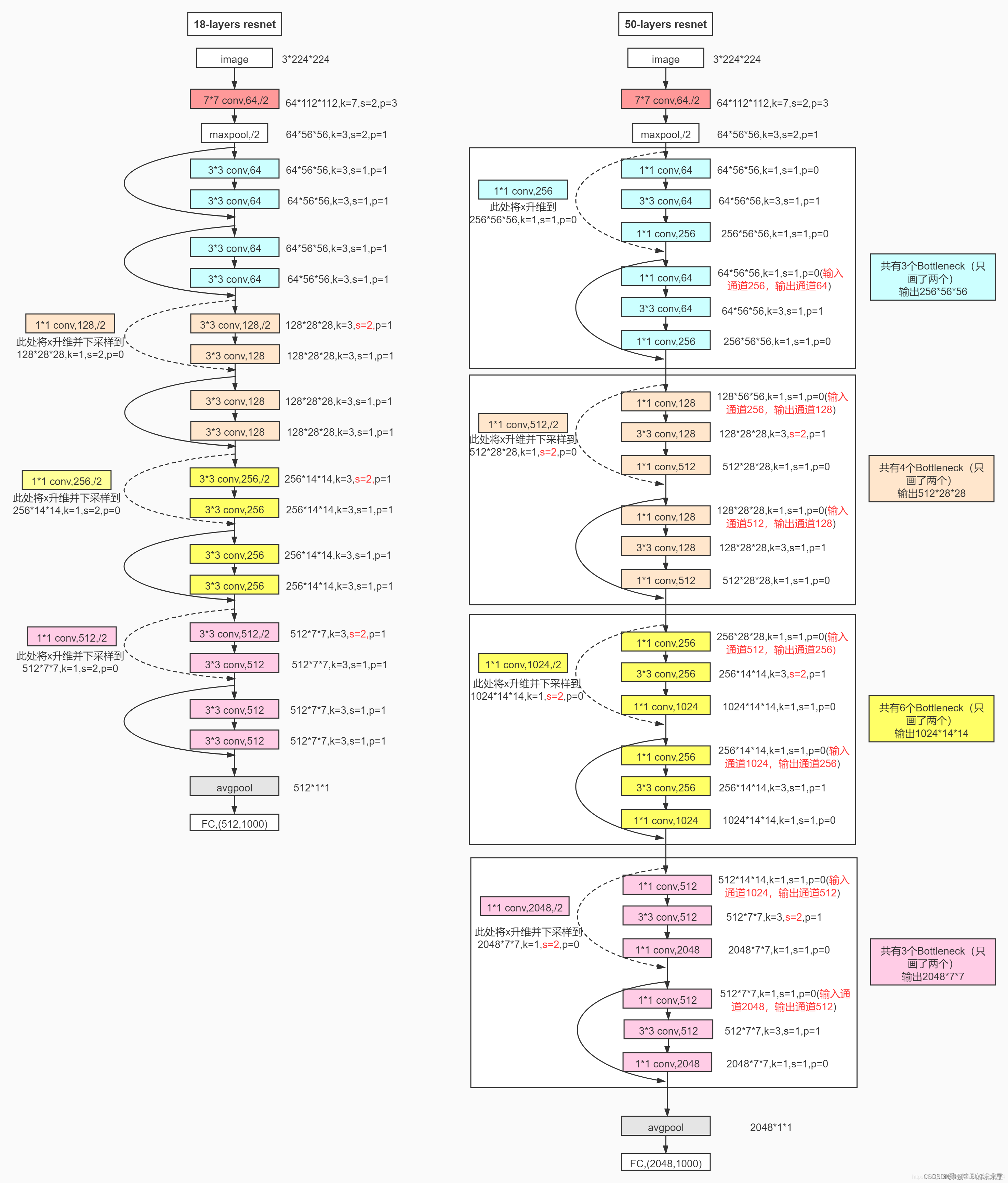
2. 实现代码
(1)ResNet101的model.py模型:
import torch
import torch.nn as nn
from torch.nn import functional as F
class DownSample(nn.Module):
def __init__(self, in_channel, out_channel, stride):
super(DownSample, self).__init__()
self.down = nn.Sequential(
nn.Conv2d(in_channel, out_channel, kernel_size=1, stride=stride, padding=0, bias=False),
nn.BatchNorm2d(out_channel),
nn.ReLU(inplace=True)
)
def forward(self, x):
out = self.down(x)
return out
class ResNet101(nn.Module):
def __init__(self, classes_num): # 指定分类数
super(ResNet101, self).__init__()
self.pre = nn.Sequential(
nn.Conv2d(3, 64, kernel_size=7, stride=2, padding=3, bias=False),
nn.BatchNorm2d(64),
nn.ReLU(inplace=True),
nn.MaxPool2d(kernel_size=3, stride=2, padding=1)
)
# --------------------------------------------------------------------
self.layer1_first = nn.Sequential(
nn.Conv2d(64, 64, kernel_size=1, stride=1, padding=0, bias=False),
nn.BatchNorm2d(64),
nn.ReLU(inplace=True),
nn.Conv2d(64, 64, kernel_size=3, stride=1, padding=1, bias=False),
nn.BatchNorm2d(64),
nn.ReLU(inplace=True),
nn.Conv2d(64, 256, kernel_size=1, stride=1, padding=0, bias=False),
nn.BatchNorm2d(256)
)
self.layer1_next = nn.Sequential(
nn.Conv2d(256, 64, kernel_size=1, stride=1, padding=0, bias=False),
nn.BatchNorm2d(64),
nn.ReLU(inplace=True),
nn.Conv2d(64, 64, kernel_size=3, stride=1, padding=1, bias=False),
nn.BatchNorm2d(64),
nn.ReLU(inplace=True),
nn.Conv2d(64, 256, kernel_size=1, stride=1, padding=0, bias=False),
nn.BatchNorm2d(256)
)
# --------------------------------------------------------------------
self.layer2_first = nn.Sequential(
nn.Conv2d(256, 128, kernel_size=1, stride=1, padding=0, bias=False),
nn.BatchNorm2d(128),
nn.ReLU(inplace=True),
nn.Conv2d(128, 128, kernel_size=3, stride=2, padding=1, bias=False),
nn.BatchNorm2d(128),
nn.ReLU(inplace=True),
nn.Conv2d(128, 512, kernel_size=1, stride=1, padding=0, bias=False),
nn.BatchNorm2d(512)
)
self.layer2_next = nn.Sequential(
nn.Conv2d(512, 128, kernel_size=1, stride=1, padding=0, bias=False),
nn.BatchNorm2d(128),
nn.ReLU(inplace=True),
nn.Conv2d(128, 128, kernel_size=3, stride=1, padding=1, bias=False),
nn.BatchNorm2d(128),
nn.ReLU(inplace=True),
nn.Conv2d(128, 512, kernel_size=1, stride=1, padding=0, bias=False),
nn.BatchNorm2d(512)
)
# --------------------------------------------------------------------
self.layer3_first = nn.Sequential(
nn.Conv2d(512, 256, kernel_size=1, stride=1, padding=0, bias=False),
nn.BatchNorm2d(256),
nn.ReLU(inplace=True),
nn.Conv2d(256, 256, kernel_size=3, stride=2, padding=1, bias=False),
nn.BatchNorm2d(256),
nn.ReLU(inplace=True),
nn.Conv2d(256, 1024, kernel_size=1, stride=1, padding=0, bias=False),
nn.BatchNorm2d(1024)
)
self.layer3_next = nn.Sequential(
nn.Conv2d(1024, 256, kernel_size=1, stride=1, padding=0, bias=False),
nn.BatchNorm2d(256),
nn.ReLU(inplace=True),
nn.Conv2d(256, 256, kernel_size=3, stride=1, padding=1, bias=False),
nn.BatchNorm2d(256),
nn.ReLU(inplace=True),
nn.Conv2d(256, 1024, kernel_size=1, stride=1, padding=0, bias=False),
nn.BatchNorm2d(1024)
)
# --------------------------------------------------------------------
self.layer4_first = nn.Sequential(
nn.Conv2d(1024, 512, kernel_size=1, stride=1, padding=0, bias=False),
nn.BatchNorm2d(512),
nn.ReLU(inplace=True),
nn.Conv2d(512, 512, kernel_size=3, stride=2, padding=1, bias=False),
nn.BatchNorm2d(512),
nn.ReLU(inplace=True),
nn.Conv2d(512, 2048, kernel_size=1, stride=1, padding=0, bias=False),
nn.BatchNorm2d(2048)
)
self.layer4_next = nn.Sequential(
nn.Conv2d(2048, 512, kernel_size=1, stride=1, padding=0, bias=False),
nn.BatchNorm2d(512),
nn.ReLU(inplace=True),
nn.Conv2d(512, 512, kernel_size=3, stride=1, padding=1, bias=False),
nn.BatchNorm2d(512),
nn.ReLU(inplace=True),
nn.Conv2d(512, 2048, kernel_size=1, stride=1, padding=0, bias=False),
nn.BatchNorm2d(2048)
)
# --------------------------------------------------------------------
self.avg_pool = nn.AdaptiveAvgPool2d((1, 1))
self.fc = nn.Sequential(
nn.Dropout(p=0.5),
nn.Linear(2048 * 1 * 1, 1000),
nn.ReLU(inplace=True),
nn.Dropout(p=0.5),
nn.Linear(1000, classes_num)
)
def forward(self, x):
out = self.pre(x)
# --------------------------------------------------------------------
layer1_shortcut = DownSample(64, 256, 1)
layer1_shortcut.to('cuda:0')
layer1_identity = layer1_shortcut(out)
out = self.layer1_first(out)
out = F.relu(out + layer1_identity, inplace=True)
for i in range(2):
identity = out
out = self.layer1_next(out)
out = F.relu(out + identity, inplace=True)
# --------------------------------------------------------------------
layer2_shortcut = DownSample(256, 512, 2)
layer2_shortcut.to('cuda:0')
layer2_identity = layer2_shortcut(out)
out = self.layer2_first(out)
out = F.relu(out + layer2_identity, inplace=True)
for i in range(3):
identity = out
out = self.layer2_next(out)
out = F.relu(out + identity, inplace=True)
# --------------------------------------------------------------------
layer3_shortcut = DownSample(512, 1024, 2)
layer3_shortcut.to('cuda:0')
layer3_identity = layer3_shortcut(out)
out = self.layer3_first(out)
out = F.relu(out + layer3_identity, inplace=True)
for i in range(22):
identity = out
out = self.layer3_next(out)
out = F.relu(out + identity, inplace=True)
# --------------------------------------------------------------------
layer4_shortcut = DownSample(1024, 2048, 2)
layer4_shortcut.to('cuda:0')
layer4_identity = layer4_shortcut(out)
out = self.layer4_first(out)
out = F.relu(out + layer4_identity, inplace=True)
for i in range(2):
identity = out
out = self.layer4_next(out)
out = F.relu(out + identity, inplace=True)
# --------------------------------------------------------------------
out = self.avg_pool(out)
out = out.reshape(out.size(0), -1)
out = self.fc(out)
return out
(2) ResNet152的model.py模型:
import torch
import torch.nn as nn
from torch.nn import functional as F
class DownSample(nn.Module):
def __init__(self, in_channel, out_channel, stride):
super(DownSample, self).__init__()
self.down = nn.Sequential(
nn.Conv2d(in_channel, out_channel, kernel_size=1, stride=stride, padding=0, bias=False),
nn.BatchNorm2d(out_channel),
nn.ReLU(inplace=True)
)
def forward(self, x):
out = self.down(x)
return out
class ResNet152(nn.Module):
def __init__(self, classes_num): # 指定了分类数目
super(ResNet152, self).__init__()
self.pre = nn.Sequential(
nn.Conv2d(3, 64, kernel_size=7, stride=2, padding=3, bias=False),
nn.BatchNorm2d(64),
nn.ReLU(inplace=True),
nn.MaxPool2d(kernel_size=3, stride=2, padding=1)
)
# -----------------------------------------------------------------------
self.layer1_first = nn.Sequential(
nn.Conv2d(64, 64, kernel_size=1, stride=1, padding=0, bias=False),
nn.BatchNorm2d(64),
nn.ReLU(inplace=True),
nn.Conv2d(64, 64, kernel_size=3, stride=1, padding=1, bias=False),
nn.BatchNorm2d(64),
nn.ReLU(inplace=True),
nn.Conv2d(64, 256, kernel_size=1, stride=1, padding=0, bias=False),
nn.BatchNorm2d(256)
)
self.layer1_next = nn.Sequential(
nn.Conv2d(256, 64, kernel_size=1, stride=1, padding=0, bias=False),
nn.BatchNorm2d(64),
nn.ReLU(inplace=True),
nn.Conv2d(64, 64, kernel_size=3, stride=1, padding=1, bias=False),
nn.BatchNorm2d(64),
nn.ReLU(inplace=True),
nn.Conv2d(64, 256, kernel_size=1, stride=1, padding=0, bias=False),
nn.BatchNorm2d(256)
)
# -----------------------------------------------------------------------
self.layer2_first = nn.Sequential(
nn.Conv2d(256, 128, kernel_size=1, stride=1, padding=0, bias=False),
nn.BatchNorm2d(128),
nn.ReLU(inplace=True),
nn.Conv2d(128, 128, kernel_size=3, stride=2, padding=1, bias=False),
nn.BatchNorm2d(128),
nn.ReLU(inplace=True),
nn.Conv2d(128, 512, kernel_size=1, stride=1, padding=0, bias=False),
nn.BatchNorm2d(512)
)
self.layer2_next = nn.Sequential(
nn.Conv2d(512, 128, kernel_size=1, stride=1, padding=0, bias=False),
nn.BatchNorm2d(128),
nn.ReLU(inplace=True),
nn.Conv2d(128, 128, kernel_size=3, stride=1, padding=1, bias=False),
nn.BatchNorm2d(128),
nn.ReLU(inplace=True),
nn.Conv2d(128, 512, kernel_size=1, stride=1, padding=0, bias=False),
nn.BatchNorm2d(512)
)
# -----------------------------------------------------------------------
self.layer3_first = nn.Sequential(
nn.Conv2d(512, 256, kernel_size=1, stride=1, padding=0, bias=False),
nn.BatchNorm2d(256),
nn.ReLU(inplace=True),
nn.Conv2d(256, 256, kernel_size=3, stride=2, padding=1, bias=False),
nn.BatchNorm2d(256),
nn.ReLU(inplace=True),
nn.Conv2d(256, 1024, kernel_size=1, stride=1, padding=0, bias=False),
nn.BatchNorm2d(1024)
)
self.layer3_next = nn.Sequential(
nn.Conv2d(1024, 256, kernel_size=1, stride=1, padding=0, bias=False),
nn.BatchNorm2d(256),
nn.ReLU(inplace=True),
nn.Conv2d(256, 256, kernel_size=3, stride=1, padding=1, bias=False),
nn.BatchNorm2d(256),
nn.ReLU(inplace=True),
nn.Conv2d(256, 1024, kernel_size=1, stride=1, padding=0, bias=False),
nn.BatchNorm2d(1024)
)
# -----------------------------------------------------------------------
self.layer4_first = nn.Sequential(
nn.Conv2d(1024, 512, kernel_size=1, stride=1, padding=0, bias=False),
nn.BatchNorm2d(512),
nn.ReLU(inplace=True),
nn.Conv2d(512, 512, kernel_size=3, stride=2, padding=1, bias=False),
nn.BatchNorm2d(512),
nn.ReLU(inplace=True),
nn.Conv2d(512, 2048, kernel_size=1, stride=1, padding=0, bias=False),
nn.BatchNorm2d(2048)
)
self.layer4_next = nn.Sequential(
nn.Conv2d(2048, 512, kernel_size=1, stride=1, padding=0, bias=False),
nn.BatchNorm2d(512),
nn.ReLU(inplace=True),
nn.Conv2d(512, 512, kernel_size=3, stride=1, padding=1, bias=False),
nn.BatchNorm2d(512),
nn.ReLU(inplace=True),
nn.Conv2d(512, 2048, kernel_size=1, stride=1, padding=0, bias=False),
nn.BatchNorm2d(2048)
)
# -----------------------------------------------------------------------
self.avg_pool = nn.AdaptiveAvgPool2d((1, 1))
self.fc = nn.Sequential(
nn.Dropout(p=0.5),
nn.Linear(2048 * 1 * 1, 1000),
nn.ReLU(inplace=True),
nn.Dropout(p=0.5),
nn.Linear(1000, classes_num)
)
def forward(self, x):
out = self.pre(x)
# -----------------------------------------------------------------------
layer1_shortcut = DownSample(64, 256, 1)
# layer1_shortcut.to('cuda:0')
layer1_identity = layer1_shortcut(out)
out = self.layer1_first(out)
out = F.relu(out + layer1_identity, inplace=True)
for i in range(2):
identity = out
out = self.layer1_next(out)
out = F.relu(out + identity, inplace=True)
# -----------------------------------------------------------------------
layer2_shortcut = DownSample(256, 512, 2)
# layer2_shortcut.to('cuda:0')
layer2_identity = layer2_shortcut(out)
out = self.layer2_first(out)
out = F.relu(out + layer2_identity, inplace=True)
for i in range(7):
identity = out
out = self.layer2_next(out)
out = F.relu(out + identity, inplace=True)
# -----------------------------------------------------------------------
layer3_shortcut = DownSample(512, 1024, 2)
# layer3_shortcut.to('cuda:0')
layer3_identity = layer3_shortcut(out)
out = self.layer3_first(out)
out = F.relu(out + layer3_identity, inplace=True)
for i in range(35):
identity = out
out = self.layer3_next(out)
out = F.relu(out + identity, inplace=True)
# -----------------------------------------------------------------------
layer4_shortcut = DownSample(1024, 2048, 2)
# layer4_shortcut.to('cuda:0')
layer4_identity = layer4_shortcut(out)
out = self.layer4_first(out)
out = F.relu(out + layer4_identity, inplace=True)
for i in range(2):
identity = out
out = self.layer4_next(out)
out = F.relu(out + identity, inplace=True)
# -----------------------------------------------------------------------
out = self.avg_pool(out)
out = out.reshape(out.size(0), -1)
out = self.fc(out)
return out
智能推荐
Python 入门的60个基础练习_练习python基础语法-程序员宅基地
文章浏览阅读4.2w次,点赞329次,收藏2.7k次。Python 入门的60个基础练习_练习python基础语法
iOS6和iOS7代码的适配(2)——status bar_ios7 statusbar-程序员宅基地
文章浏览阅读1w次。用Xcode5运行一下应用,第一个看到的就是status bar的变化。在iOS6中,status bar是系统在处理,应用_ios7 statusbar
gdb调试时No symbol "var" defined in current context && No Register_no registers调试显示-程序员宅基地
文章浏览阅读2.1k次。问题描述:,在gdb调试程序输出变量:p var,会提示No symbol "var" in current context.原因:程序编译时开启了优化选项,那么在用GDB调试被优化过的程序时,可能会发生某些变量不能访问,或是取值错误码的情况。这个是很正常的,因为优化程序会删改程序,整理程序的语句顺序,剔除一些无意义的变量等,所以在GDB调试这种程序时,运行时的指令和你所编写指_no registers调试显示
IDGeneratorUtil 主键id生成工具类_idgeneratorutils.generateid()-程序员宅基地
文章浏览阅读3.4k次。import java.util.Random;import org.drools.util.UUIDGenerator;/** * * * 类名称:GenerateIdUtil * 类描述: 主键生成工具类 * @author chenly * 创建时间:Jul 10, 2012 8:10:43 AM * 修改人: * 修改时间:Jul 10, 2012 8..._idgeneratorutils.generateid()
关于汇编 BX 和 BLX 跳转指令_汇编blx-程序员宅基地
文章浏览阅读5k次。BX:跳转到寄存器reg给出的目的地址处,如:BX R2BLX:跳转到寄存区reg给出的目的地址处并将返回地址存储到LR(R14)使用这两个指令时有一点特别需要注意:跳转的目的地址必须是奇数,若不是奇数则在后面加1,如某函数的起始地址是0x80000f00,则要跳转到此函数则应该跳转到0x80000f01处!否则会进入硬件错误中断!..._汇编blx
前端vue,打包整合进后端springboot的resources里面后,运行只要刷新就报404_前端项目放入resource-程序员宅基地
文章浏览阅读2.6k次,点赞2次,收藏4次。vue打包后,其实就剩index.html和一堆静态资源,页面的加载和替换都是通过刷新index.html种的dom来实现的(应该是这样,可能表述不是很好),所以做个重定向就可以了。(博主是这么解决的,网上还有很多人是各种路径错误,大家可以尝试下自己是哪个原因)import org.springframework.boot.web.server.ConfigurableWebServerFa..._前端项目放入resource
随便推点
添加远程github仓库时报错 Warning: Permanently added the RSA host key for IP address 52.74.223.119_cmd warning: permanently added-程序员宅基地
文章浏览阅读9.7k次。1.问题展示2.解决方案1.任意窗口, 打开git bash2.命令行界面, 输入cd C:3.cat ~/.ssh/id_rsa.pub正常下面应该显示一大串公钥如果没有,显示如下图, 则进行下一步, 创建公钥4.创建公钥, 输入 ssh-keygen5.然后一直下一步, 直到出现6.再次输入cat ~/.ssh/id_rsa.pub下面一大串数字便是公钥,复制这些字符串, 打开github, 点击头像, 打开settings, 打开SSH and GPG Keys_cmd warning: permanently added
SQL*Plus 使用技巧1-程序员宅基地
文章浏览阅读154次。[code="java"]1. SQL/Plus 常用命令 a. help [topic] 查看命令的使用方法,topic表示需要查看的命令名称。 如: help desc; b. host 该命令可以从SQL*Plus环境切换到操作系统环境,以便执行操作系统命名。 c. host [command] 在sql*plus环境中执行操作系统命令,如:host notepad.exe..._sql+plus的使用方法
域控服务器搭建与管理论文,校园网络服务器的配置与管理 毕业论文.doc-程序员宅基地
文章浏览阅读441次。该文档均来自互联网,如果侵犯了您的个人权益,请联系我们将立即删除!**学校毕 业 论 文**学校园网络服务器的配置与管理姓 名: **学 号: **指导老师:系 名:专 业: 计算机网络技术班 级:二0一一年十二月十五日摘 要随着网络技术的不断发展和Internet的日益普及,许多学校都建立了校园网络并投入使用,这无疑对加快信息处理,提高工作效..._服务器配置与应用论文
mysql单实例多库与多实例单库_数据库单实例和多实例-程序员宅基地
文章浏览阅读1k次。一、单实例多库:一个mysql实例,创建多个数据目录。规划:实例路径:/usr/local/mysql数据目录路径:(1)/usr/local/mysql/data(2)/usr/local/mysql/data2步骤:安装mysql。配置my.cnf文件。初始化各个数据库。用mysqld_multi启动。1、安装mysql。平常安装。2、m..._数据库单实例和多实例
MFC解决找不到MFC90.DLL的问题_microsoft v90.debugmfc-程序员宅基地
文章浏览阅读6.3k次。今天装了第三方的MFC软件库Xtreme ToolkitPro v15.0.1,听说搞MFC的人都知道它的强大,我刚学习,所以装了一个,然后想运行一下它自带的例子看看。出现一个“找不到mfc90.dll“的问题,百度一下,记录如下:vs2008已经打过sp1补丁,编译C++程序会提示找不到mfc90.dll文件的错误,但是如果是release版的话就能正常运行csdn看到解决方案,粘贴_microsoft v90.debugmfc
XeLaTeX-中文排版解决方案_latex 中文排版 texlive-程序员宅基地
文章浏览阅读2.1k次。以前使用CJK进行中文的排版,需要自己生成字体库,近日,出现了XeTeX,可以比较好的解决中文字体问题,不需要额外生成LaTeX字体库,直接使用计算机系统里的字体,本文以在Linux下为例说明XeTeX的使用。操作系统: UbuntuTeX:除了texlive包外,还需要安装的包是texlive-xetex。字体:可以使用fc-list查看你自己的字体库,注意字体的完整名称,在XeTe..._latex 中文排版 texlive